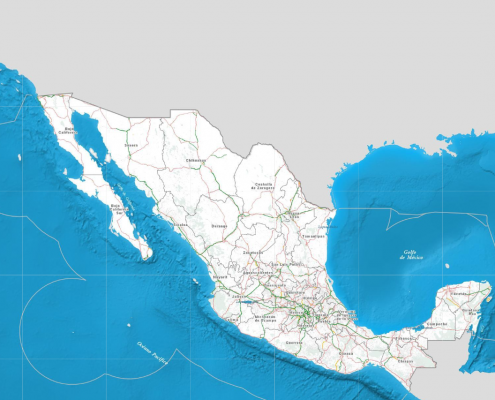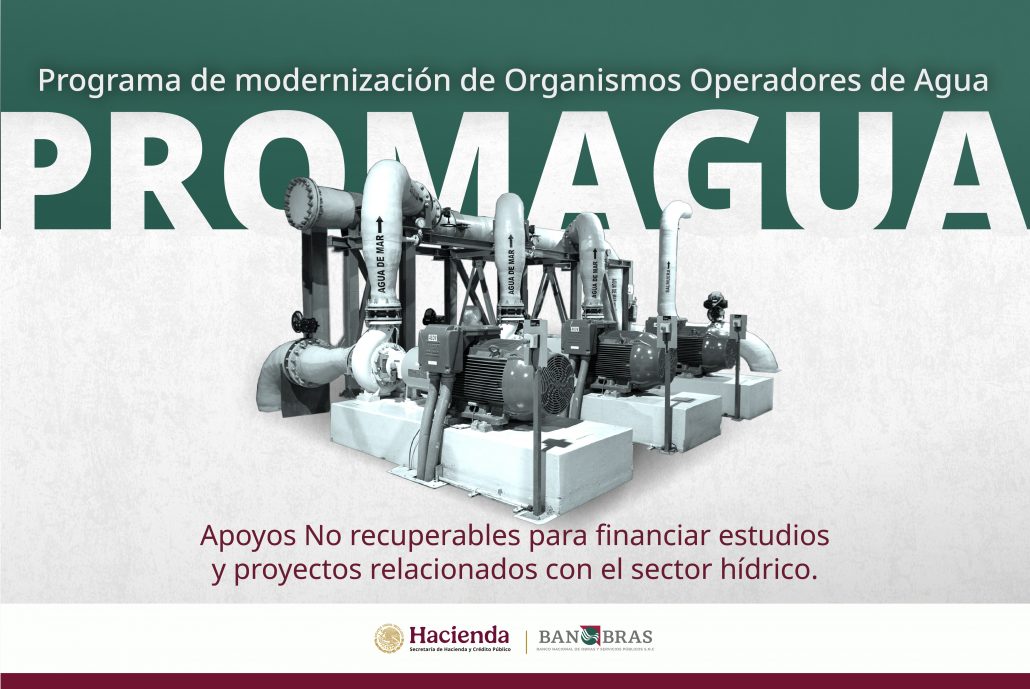Last review: December, 2025
Banobras offers interested parties information on the sector in Mexico with data from various sources in order to provide knowledge on the subject and useful elements for decision-making at the sectoral level. The content presented does not reflect the position of Banobras.
DOF: DECREE issuing the General Water Law and amending, adding to and repealing various provisions of the National Water Law. (11/12/25). View document
MDPI: The Groundwater Management in the Mexico Megacity Peri-Urban Interface. View document
Current status
According to the document “Water Statistics in Mexico 2023-2024” by Conagua, Mexico has a total of 461,640 million cubic meters of renewable water, which averages to 3,569 cubic meters per inhabitant per year. However, water availability varies significantly by geographic location. The northern, central, and northwestern regions host the majority of the population and economic activity, yet have significantly lower renewable water availability compared to the southeastern region.
The distribution of the volumes granted for consumptive uses reflects the allocation of water resources according to different sectoral needs:
- 76% Agriculture
- 15% Public Supply
- 5% Self-supplied Industry
- 4% Electric Power (excluding hydroelectric)
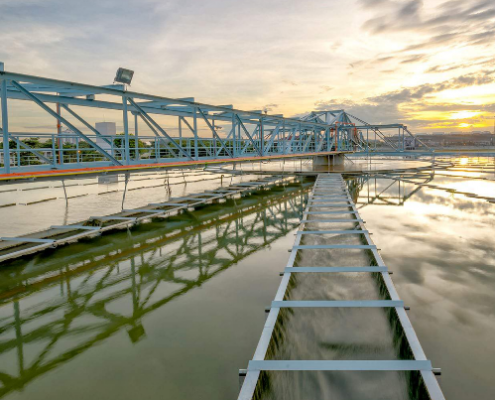
Source: CONAGUA, 2023
- Approximately 6,500 storage dams and reservoirs.
- 6.7 million hectares with irrigation.
- 2.8 million hectares with technified rain-fed agriculture.
- 96.1% of the population has access to drinking water.
- 93.8% of the population has access to sewage systems.
- 984 drinking water treatment plants in operation.
- 2,872 municipal wastewater treatment plants in operation.
- 3,745 industrial wastewater treatment plants in operation.
- Over 3,000 km of aqueducts.
The area with irrigation infrastructure is approximately 6.6 million hectares, of which 3.3 million correspond to 86 irrigation districts (DR) and the remaining 3.3 million to nearly 51,000 irrigation units (UR). The DR are irrigation projects developed by the Federal Government, including storage reservoirs, direct diversions, pumping plants, wells, canals, and roads, among others. The UR are agricultural areas with infrastructure and irrigation systems distinct from the irrigation districts, generally covering smaller areas.
For the agricultural year 2021-2022 in the irrigation districts (DR), the main crops by harvested area were corn, wheat, sorghum, alfalfa, sugarcane, and beans, which together accounted for 54.9% of the harvested area. These six crops represented 60.6% of the production in tons and 49.6% of the production value in thousands of pesos.
Municipal water treatment plants improve the quality of water from surface or groundwater sources to make it suitable for human consumption. In 2022, 113.9 m³/s were treated in 988 treatment plants.
On November 21, 2024, the Government of Mexico presented the 2024-2030 National Water Plan, which aims to guarantee the human right to water in sufficient quantity and quality, promote responsible management of water resources, and ensure their long-term sustainability.
The plan is based on four main pillars:
- Water policy and national sovereignty
- Justice and access to water
- Environmental impact mitigation and climate change adaptation
- Integrated and transparent management
The following actions will also be implemented:
- A government investment of approximately 20 billion pesos for water projects in 2025.
- Strategic projects targeting regions with the greatest need for access to the human right to water, including: Presa El Novillo en La Paz, Baja California Sur; Desaladora Playas de Rosarito, en Baja California; Sistema de presas en Hermosillo, Sonora; Presa Tunal II en Durango; Presa Milpillas en Zacatecas; el Acueducto Ciudad Victoria II, en Tamaulipas; Presa Las Escobas en San Luis Potosí; Redes troncales para el proyecto Agua Saludable en Durango y Coahuila; el Acueducto Solís en León, Guanajuato; Acueducto Zacualpan II en Colima; Acueducto La Cangrejera-Coatzacoalcos en Veracruz; Presa Paso Ancho en Oaxaca; Acuaférico en Campeche; Obras de protección contra inundaciones en Tabasco; el Plan integral para Acapulco y el Plan integral para la Zona Metropolitana del Valle de México.
- “Master Infrastructure Plan” to finance projects through federal programs: Rights Refund Program (PRODDER), Wastewater Treatment Program (PROSANEAR), Drinking Water, Drainage, and Treatment Program (PROAGUA), Social Infrastructure Contribution Fund (FAIS), and Direct Federal Investment.
- Regulation of concessions
- Creation of the National Water Registry for Well-being (Renab) with a single database for efficient, transparent management with zero corruption
- Conducting an inspection program nationwide to regulate water use and exploitation
- Promoting reforms to the National Water Law and the enactment of the General Water Law
- Issuance of a decree to facilitate the regularization of expired concessions and access to subsidies, credits, and programs
- SEMARNAT-CONAGUA sanitation for the ecological restoration of the Lerma-Santiago, Atoyac, and Tula rivers
- Signing of the National Agreement for the Human Right to Water and Sustainability on November 25, 2024.
Institutional Arrangement
National Water Program 2020-2024
Organizational Structure
Description of the hierarchy and roles of the different entities and actors involved in the sector, including how the different institutions and agencies coordinate and collaborate.
It is the federal government agency and authority responsible for the sector, tasked with integrating criteria and instruments into various areas of society and public functions to ensure the optimal protection, conservation, and utilization of the country’s natural resources, thus forming a comprehensive and inclusive environmental policy aimed at achieving sustainable development.
A decentralized body of SEMARNAT responsible for preserving national waters and their inherent public assets for sustainable management and ensuring water security, with the responsibility shared among different levels of government and society as a whole.
The National Water Commission (Conagua) carries out its functions through 13 Basin Organizations, whose scope of authority corresponds to the Hydrological-Administrative Regions (RHA, in Spanish), composed of groups of watersheds, considered the basic units for water resource management. The municipalities that make up each RHA are specified in the Territorial Jurisdiction Agreement of the Basin Organizations, published in the Official Gazette of the Federation (DOF) on April 1, 2010. In the federal entities where there are no headquarters of the Basin Organizations, Conagua operates through Local Directorates.
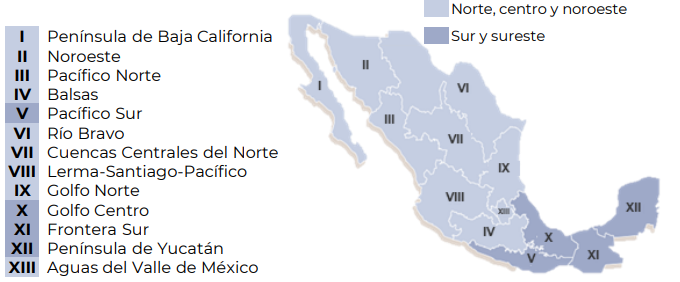
Units of CONAGUA responsible for implementing the commission’s policies, strategies, programs, and actions in the corresponding federal entities, coordinating with municipal and state operating organizations.
A decentralized body of SEMARNAT focused on addressing national and regional challenges related to water management and shaping new approaches in research and technological development to protect the resource and allocate it efficiently and equitably among different users.
Institutional Program of the Mexican Institute of Water Technology 2025-2030
Local authorities responsible for providing the public services related to the supply of drinking water and sewage at the state and municipal levels. According to the Political Constitution of the United Mexican States, municipalities are in charge of functions and public services related to drinking water, drainage, sewage, treatment, and disposal of wastewater.
The Federal Government, through the National Infrastructure Fund (FONADIN), created the Water Operator Modernization Program (PROMAGUA), which supports the structuring and financing of water projects through Public-Private Partnership (PPP) schemes.
Legal system
The compilation of international treaties, laws, regulations, decrees, agreements and federal, state and municipal provisions shown here are for informational purposes and for ease of reference:
SEMARNAT / CONAGUA
Public Works and Related Services Law
National Waters Law
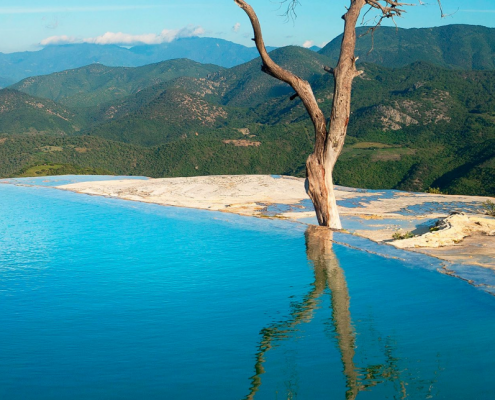
Source: CONAGUA, Water Statistics in Mexico, 2023
Investment cycle
The following section provides an overview of the project development process from initial planning to final execution.
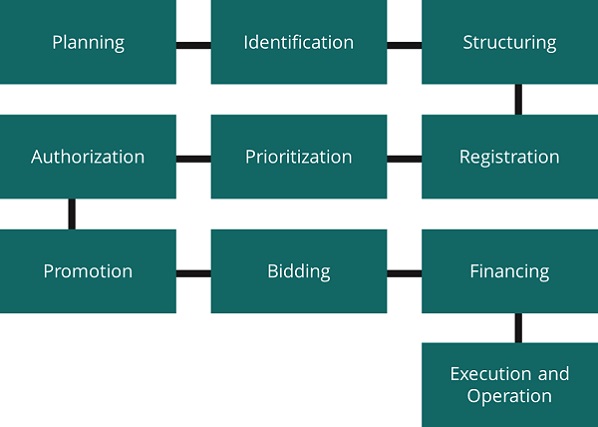
Planning
CONAGUA establishes short, medium and long term sectorial programs, following the guidelines of the National Water Plan (PNH) 2020-2024, which is the document that rules the national water policy. The PNH is a special program derived from the National Development Plan 2020-2024 and the Sectorial Environment Program 2020-2024.
Identification
CONAGUA identifies water projects to be developed, based on planning documents. Unsolicited proposals of PPP projects should be aligned to this plans. At a subnational level, FONADIN’s Program to Modernize Water Operating Water Agencies (PROMAGUA) provides support for project identification.
Structuring
The Planning Deputy Direction of CONAGUA structures the projects to be developed, by identifying the needs of the sector. Subnational projects benefited by PROMAGUA are structured with FONADIN’s assistance.
Registration
For those projects that require federal funds (including FONADIN funding), CONAGUA presents a registration application to the Investment Unit of the Ministry of Finance.
Prioritization
The CIGFD will evaluate the projects that require the allocation of federal funds, and will decide its inclusion in the draft of the annual expenditure budget. Additionally, this commission will determine the prioritization of the projects based on: a) socioeconomic profitability; b) its impact in extreme poverty reduction; c) regional development, and d) concurrence with other programs and investment projects.
Autorización
- Projects that require federal funds are authorized by the House of Representatives.
- Projects with funding from FONADIN /PROMAGUA are authorized by the Fund.
Promotion
CONAGUA, basin administrations and state and local agencies are responsible for the promotion of the projects.
Bidding
The bidding process is responsibility of CONAGUA, basin administrations and state and local agencies, and the process must be registered in CompraNet.
Financing
Different sources of funds are available for the projects, depending on their particular characteristics and their financial structure, including federal funds or PEF, and funds form FONADIN, BANOBRAS, commercial banks, institutional and private developers, and from institutional investors.
Execution and Operation
Carried out by the awarded operators and/or developers, under the surveillance of CONAGUA, basin administrations and state and local agencies, according to contract terms.
Projects
Information on new projects (pre-investment, bidding and execution) and in operation within the Mexico Projects Hub platform, which at some stage of the project were considered investment opportunities and do not necessarily have Banobras / Fonadin participation.
New Projects
| Project | Sector | Subsector | Stage | Sustainability | With Ally Networks |
| 0998 Construction of the Armería Diversion Dam, Colima | Water and Environment | Water Supply | Preinvestment | No | No |
| 0994 Chiná Aqueduct and Campeche Waterway | Water and Environment | Water Supply | Preinvestment | No | No |
| 0993 Paso Ancho Dam | Water and Environment | Water Supply | Preinvestment | No | No |
| 0991 Improvement, expansion and sectorization of the drinking water network in Xpujil, Calakmul | Water and Environment | Water Supply | Preinvestment | No | No |
| 0989 “Agua para Colima” Aqueduct | Water and Environment | Water Supply | Preinvestment | No | No |
| 0988 Milpillas Dam | Water and Environment | Water Supply | Preinvestment | No | No |
| 0987 Healthy Water Trunk Networks for La Laguna | Water and Environment | Water Supply | Bidding | No | No |
| 0985 El Novillo Dam in Baja California Sur | Water and Environment | Water Supply | Preinvestment | No | No |
| 0984 Solis Dam Aqueduct | Water and Environment | Water Supply | Preinvestment | No | No |
| 0983 Hermosillo Dam System | Water and Environment | Water Supply | Preinvestment | No | No |
| 0982 Works from “Acapulco se transforma contigo” program in Guerrero | Water and Environment | Others | Preinvestment | No | No |
| 0977 Ciudad Victoria II Aqueduct | Water and Environment | Water Supply | Preinvestment | No | No |
| 0973 Flood protection works in Tabasco | Water and Environment | Others | Preinvestment | No | No |
| 0964 Rosarito desalination plant | Water and Environment | Water Supply | Preinvestment | No | No |
| 0962 Potable Water Extraction Zone for the Supply to Tulum City | Water and Environment | Water Supply | Preinvestment | No | No |
| 0912 Expansion of the “El Ahogado” WWTP | Water and Environment | Water sanitation | Execution | Yes | Yes |
| 0907 Tunal II Dam in Durango, Dgo. | Water and Environment | Water Supply | Preinvestment | No | No |
| 0016 Desalinization Plant of Los Cabos, Baja California Sur | Water and Environment | Water Supply | Execution | Yes | Yes |
| 0015 Water Management of Los Cabos, B.C.S. Integral Improvement | Water and Environment | Water Management | Execution | Yes | Yes |
Projects in Operation
| Proyect | Sector | Subsector | Sustainability | Ally Networks |
| 0942 Durango Potabilization Plant | Water and Environment | Water Supply | Yes | Yes |
| 0840 WWTP El Ahogado | Water and Environment | Water Sanitation | Yes | Yes |
| 0839 Desalination Plant of Ensenada | Water and Environment | Water Sanitation | Yes | Yes |
| 0600 WWTP Bahia de Banderas | Water and Environment | Water Sanitation | Yes | No |
| 0599 WWTP Hermosillo | Water and Environment | Water Sanitation | Yes | No |
| 0598 WWTP Atotonilco | Water and Environment | Water Sanitation | Yes | Yes |
| 0010 Desalinization Plant of Guaymas and Empalme, Sonora | Water and Environment | Water Supply | Yes | Yes |
Strategic Projects
| Project | Sector | Subsector | Stage | Sustainability | With Ally Networks |
|---|---|---|---|---|---|
| 1041 Lago de Guadalupe Dam Water Utilization System | Water and Environment | Water Supply | Bidding | No | No |
| 1028 Water for San Luis Potosí | Water and Environment | Water Supply | Bidding | No | No |
| 1017 Construction of the new drinking water supply source in Coatzacoalcos | Water and Environment | Water Supply | Execution | No | Yes |
| 0998 Construction of the Armería Diversion Dam, Colima | Water and Environment | Water Supply | Execution | No | No |
| 0994 Agua para Campeche: Chiná Aqueduct and Campeche Waterway | Water and Environment | Water Supply | Execution | Yes | No |
| 0993 Margarita Maza (Paso Ancho) Dam | Water and Environment | Water Supply | Bidding | No | No |
| 0991 Agua para Campeche: Improvement of the drinking water network in Xpujil, Calakmul | Water and Environment | Water Supply | Execution | No | No |
| 0989 "Agua para Colima" Aqueduct | Water and Environment | Water Supply | Execution | No | No |
| 0988 Milpillas Dam | Water and Environment | Water Supply | Preinvestment | No | No |
| 0987 Trunk Networks Agua Saludable para La Laguna | Water and Environment | Water Supply | Execution | No | No |
| 0985 El Novillo Dam in Baja California Sur | Water and Environment | Water Supply | Execution | No | No |
| 0984 Solis-Leon Aqueduct | Water and Environment | Water Supply | Execution | No | No |
| 0983 Hermosillo Dam System | Water and Environment | Water Supply | Preinvestment | No | No |
| 0982 Works from "Acapulco se transforma contigo" program in Guerrero | Water and Environment | Others | Bidding | No | No |
| 0977 Ciudad Victoria II Aqueduct | Water and Environment | Water Supply | Execution | Yes | No |
| 0973 Flood protection works in Tabasco | Water and Environment | Others | Bidding | No | No |
| 0964 Rosarito desalination plant | Water and Environment | Water Supply | Bidding | No | No |
| 0962 Potable Water Extraction Zone for the Supply to Tulum City | Water and Environment | Water Supply | Preinvestment | No | No |
| 0907 Tunal II Dam in Durango, Dgo. | Water and Environment | Water Supply | Execution | Yes | Yes |
| 0016 Desalinization Plant of Los Cabos, Baja California Sur | Water and Environment | Water Supply | Execution | Yes | Yes |
| Project | Sector | Subsector | Stage | Sustainability | With Ally Networks |
|---|---|---|---|---|---|
| 0942 Durango Potabilization Plant | Water and Environment | Water Supply | Operation | Yes | Yes |
| 0912 Expansion of the “El Ahogado” WWTP | Water and Environment | Water sanitation | Operation | Yes | Yes |
| 0840 WWTP El Ahogado | Water and Environment | Water sanitation | Operation | Yes | Yes |
| 0839 Desalination Plant of Ensenada | Water and Environment | Water sanitation | Operation | Yes | Yes |
| 0600 WWTP Bahia de Banderas | Water and Environment | Water sanitation | Operation | Yes | No |
| 0599 WWTP Hermosillo | Water and Environment | Water sanitation | Operation | Yes | No |
| 0598 WWTP Atotonilco | Water and Environment | Water sanitation | Operation | Yes | Yes |
| 0015 Water Management of Los Cabos, B.C.S. Integral Improvement | Water and Environment | Water Management | Operation | Yes | Yes |
| 0010 Desalinization Plant of Guaymas and Empalme, Sonora | Water and Environment | Water Supply | Operation | Yes | Yes |
Banobras / Fonadin
Financing for States, Municipalities, and Decentralized Public Organizations: Banobras addresses the infrastructure needs of states, municipalities, and their decentralized public organizations.

- Technical Assistance to States, Municipalities, and Their Organizations: This involves training, workshops, and advisory services for public administration officials aimed at strengthening their management and revenue collection capabilities, as well as project evaluation.
- Training for Officials of Water Operating Organizations: It provides a working methodology that aligns actions for the collection of fees for water supply and drainage discharge from delinquent users, updates the user registry through the detection of irregular connections and derivations, identifies changes in diameter and usage characteristics, analyzes regions by service type for tariff updates, and implements effective procedures in both the short and medium term.
Directory: Promotion Offices
Trust Bussineses
Trust Fund to Support the Mexico Valley Sanitation Project: Its purpose is to cover, using its assets, on behalf of and at the direction of the Technical Coordinator of the Project (the National Water Commission), or the Local Technical Coordinators (Water System of Mexico City and Water Commission of the State of Mexico), the acquisitions, leases, services, and hydraulic infrastructure works in the Metropolitan Zone of the Mexico Valley and its area of influence, or those directly related to these.
Project Development: Banobras offers services aimed at assisting public sector agencies and entities in the development of infrastructure projects.
Financial structuring of the project:
- Elaborate and/or update studies required by the Public-Private Partnerships Law.
- Support in the review of the bidding conditions and contract model.
- Assist in obtaining financing for the project.
- Assist in the registration process of the project in the portfolio of the Investment Unit of the Ministry of Finance and Public Credit (SHCP).
- Assist in dealing with any observations made by the SHCP Investment Unit.
- Support in the financial closing of the project.
Program for the Modernization of Water Operating Organizations (PROMAGUA)
It allocates non-recoverable funds for the partial financing of studies and projects that contribute to the operational and financial sustainability of public entities related to the sector.
Contact: fonadin.agua@banobras.gob.mx

It has a wide range of products designed to strengthen the financial structure of the infrastructure projects that the country requires, from the conception to the completion of the projects, providing the following financial instruments that make the projects more attractive for financing with private resources:
Recoverable Support
- Simple Credits
- Subordinated Credits
- Guarantees
- Investments in Venture Capital Funds
- Infrastructure Trust Investments
- Financing of Studies and Advisory Services
Non Recoverable Support
- Contributions for Studies and Consultancy
- Contributions for Projects
- Project Grants
Sustainability
Banobras makes available to interested parties, analysis sheets for the detection of sustainability practices in infrastructure projects, in accordance with the methodological framework “Attributes and Framework for Sustainable Infrastructure” of the Inter-American Development Bank (IDB). Its objective is to highlight sustainable practices, encourage their adoption in future projects and provide relevant information for investors in their economic, environmental, social and institutional dimensions.
To consult the projects that already have a sustainability record, select the “SEARCH CRITERIA>” option in the PROJECTS section, and then select “With Sustainability Analysis”; the projects that have a record will be displayed below.
In addition, Banobras offers an analysis tool that presents the potential relationship of the different infrastructure projects of the Mexico Projects platform with the 17 Sustainable Development Goals (SDGs) of the 2030 Agenda and their targets. This comparative analysis facilitates the use of data according to different criteria, such as the potential impact of projects and sectors against national and global development goals.
The comparison is only made between projects in the same subsector. To select and consult here.
The alignment of a project with the SDGs provides information on the degree of focus on sustainability; it provides a comparison between projects in the same sector and sub-sector and facilitates investment decisions, showing the highest and lowest alignment of projects to the SDGs. Comparative analysis facilitates the use of data according to different criteria, such as the potential impact of projects and sectors against national and global development goals.
In the case of the sector, 11 projects are identified in the platform that have sustainability practices detection sheets, which allows to know, among other things, the projects with more and better alignments to the SDGs. For more information, access the Sustainable Development Goals application:
Greater alignment of the sector:
- SDG 11: Sustainable Cities and Communities
- SDG 9: Industry, Innovation, and Infrastructure
- SDG 8: Decent work and economic growth
Reduced alignment of the sector:
- SDG 14: Life Below Water
- SDG 4: Quality Education
- SDG 2: Zero Hunger
Ally Networks
Banobras, through its Ally Networks application, provides information on companies participating in competitive public procurement processes for infrastructure projects in Mexico, based on official sources such as ComprasMX. It includes details on investment amounts, number of participations in bids, projects awarded, consortiums, and business associations, which allows the user to identify potential actors for the establishment of investments in the country.
To consult the projects that have information on the participating companies, select the option “SEARCH CRITERIA>” in the PROJECTS section, and then select “With applicant companies” at the end of the criteria.
In the application, you can consult on the sector:
- 8 projects
- 60 companies
- 21 consortiums
- 10 Projects
- 106 Companies
- 38 Consortiums
Reference documents
This section offers documents, reports and reports with technical, statistical and regulatory information on the sector:
Official statements:
2025
- 12/11/2025 DOF: DECREE issuing the General Water Law and amending, adding to and repealing various provisions of the National Water Law.
- 11/29/2025 CONAGUA: Administrative Facilitation Decree.
- 11/05/2025 Government of Mexico: National Irrigation Modernization Program at 40% progress
- 10/28/2025 DECREE establishing administrative facilitation measures to regularize the water concession and allocation titles granted to the specified users of national waters.
- 10/19/2025 CONAGUA: Reform initiative and new law on water matters strengthen the human right to water and the State’s authority.
- 10/01/2025 Presidency of the Republic: Initiative to issue the General Water Law and reform to the National Water Law returns the water to the nation: President.
- 09/20/2025 Presidency of the Republic: “México se Tecnifica” Historic investment of more than 60 billion MXN for irrigation districts to guarantee water as a right.
- 03/12/2025 Presidency of the Republic: The Government of Mexico, through the National Water Commission (Conagua), presented 17 Water Infrastructure Projects as part of the National Water Plan, which will have a six-year investment of 122.6 billion pesos (MXN).
- 02/28/2025 DOF: Operating Rules of the Drinking Water, Drainage, and Treatment Program (PROAGUA), under the responsibility of the National Water Commission, applicable from 2025.

